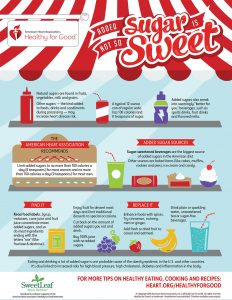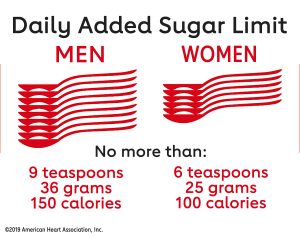Added Sugars
It’s no secret that most Americans consume too much sugar on a regular basis. This is especially true for added sugars. On average, most adults have around 17 teaspoons (or 84 grams) of added sugar daily- which is much higher than most health organizations recommend. The American Heart Association recommends limiting added sugar to 6 teaspoons (25 grams) a day for women and children and 9 teaspoons (36 grams) a day for men. The Dietary Guidelines for Americans recommend adults limit added sugars to less than 10% of daily calories. For someone following a 2,000 calorie diet, this equals approximately 12 teaspoons (48 grams) of added sugar. To put this in perspective, one 12oz can of regular Coke alone has 39 grams of added sugar.
What is Added Sugar?
Sugar in foods can either be natural or added. Natural sugars are those that are already naturally present in foods such as fruits and dairy products. These sources of natural sugar also provide several different nutrients, making them a more preferred option. While it is possible to consume an excessive amount of sugar from too much fruit, this is rarely the problem for most individuals. In fact, most people do not eat enough fruit on a regular basis. Added sugars are those that are added to foods during processing, when cooking, or before eating. Added sugars can be used as a preservative in certain foods, as a bulking source in things like ice cream, and to enhance flavor and texture. Most items that are high in added sugars have a lower nutrient profile and contain a higher amount of empty calories. While some companies may try to market their product as “healthier” or “better for you” by claiming they use raw sugar, agave, etc., it is important to note that our bodies process all sugar in the same way.
Foods That Have High Amounts of Added Sugar
Some of the major sources of added sugar include sodas, energy drinks, fruit drinks, candy, cookies, pies, ice cream, sweetened yogurts, sweetened cereals, granola bars, flavored instant oatmeal, syrup, jelly, BBQ sauce, ketchup, and other baked goods. The American Heart Association states that close to half of added sugar intake comes from sugary drinks alone.

Other Names for Sugar
Sugar can come in many different forms. When looking at the ingredient list on the nutrition facts label, any word ending in “ose” is most likely going to be a source of sugar. Some other common names you may see for added sugar include high fructose corn syrup, molasses, corn sweetener, raw sugar, syrup, honey, nectars, cane sugar, malt, or fruit juice concentrate.

Too Much Added Sugar
Added sugar in excess can potentially increase the risks of many health complications such as cardiovascular disease, insulin resistance, diabetes, kidney disease, obesity, tooth decay, and certain cancers. Added sugars contribute extra calories but provide little to no nutritional value.
Ways to Limit
First, take a moment to try and identify where most of your added sugar intake is coming from. If you are someone who tends to drink more regular soda, sweet tea, or concentrated fruit juice, try slowly replacing those drinks with others such as water, unsweet tea, sparkling water, or diet soda. You can also add things like fruit or flavor enhancers to regular or sparkling water for a different taste. Try replacing some fruit juice with a piece of fruit to help increase intake of fiber and vitamins. Cooking more at home helps to control how much sugar is added to certain dishes. Try limiting intake of sweets and desserts or at least reduce the overall portion size of these foods. Cutting out sugar completely rarely works. Instead, try reducing your intake a little at a time to get more accustomed. Regardless of which type of sugar you prefer, try using a little less and see how your taste buds adjust.
Resources
https://www.cdc.gov/nutrition/data-statistics/added-sugars.html
https://www.heart.org/en/healthy-living/healthy-eating/eat-smart/sugar/sugar-101

